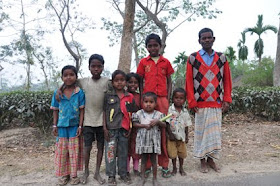
Commercial tea production in Banglasdesh dates to the early/mid 1800's. Bangladesh is one of the top ten largest tea producing and exporting countries in the world. Most of the tea producing estates are in the north eastern region of Bangladesh, there are some in the south east. Many still have British interests. The picking season runs from March to December, during the wetter months, so all was relatively quiet.
 We hired some bicycles and set off on a ride around the area and the tea gardens, the light barks of the trees standing out above the tea plants made bands of colour. They reminded me of the eucalyptus trees lining the roads in central Australia.
We hired some bicycles and set off on a ride around the area and the tea gardens, the light barks of the trees standing out above the tea plants made bands of colour. They reminded me of the eucalyptus trees lining the roads in central Australia.  The markings on the trees identified boundaries and ownership
The markings on the trees identified boundaries and ownership

 We didnt go into the plantations, we visited the nearby villages around Shrimongal.
We didnt go into the plantations, we visited the nearby villages around Shrimongal. Many of the inhabitants who work on the plantations are descendants of hindu tribal groups brought in to the area from other regions of India (Orissa, Bihar and West Bengal) specifically to work on the plantations, they are self contained and have developed their own distinct culture and language. Much has been written and reported on the health, living and working conditions of tea plantation workers.

In the village the women were gathered around the pump to collect water.
 The houses and earth yards are decorated with adobe paintings using chalk, charcoal, cow or goat dung and clay. The designs are sometimes for ritual (some were linked to local stick dancing rites or Rangoli/ Alpana), sometimes to mark boundaries, sometimes to beautify.
The houses and earth yards are decorated with adobe paintings using chalk, charcoal, cow or goat dung and clay. The designs are sometimes for ritual (some were linked to local stick dancing rites or Rangoli/ Alpana), sometimes to mark boundaries, sometimes to beautify.



Women regulary repaint and decorate an area outside of the house, sometimes as part of puja.















